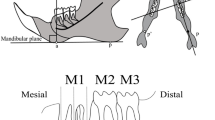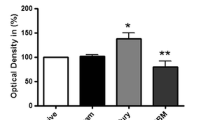Summary
Traumatic occlusion provides a trauma that affects the whole tooth and its supporting tissues. To study the effect of this trauma on CGRP and SP immunoreactive nerve morphology in pulp and periodontium, traumatic occlusion was induced in 2-months-old rats. The occlusal surface of the first maxillary molar in 30 rats were unilaterally raised 1 mm with a composite material. At different observation periods up to 30 days, the rats were transcardiacally perfused, the jaws demineralized, sectioned and processed for immunohistochemistry with the avidin-biotin-peroxidase method. Changes in nerve morphology, distribution and density in first and second molars and their supporting tissues were analyzed and compared in experimental (n=30) and control rats (n=14). Already after 5 days with traumatic occlusion, 22% of the experimental teeth had increased density of CGRP and SP immunoreactive nerves locally in gingiva, the periodontal ligament and the pulp, while in 15%, axonal proliferation and changed nerve morphology were found in the whole pulp (severe reaction). During a 20-day period, the pulpal nerve reactions progressed and included the whole pulp in 46% of the experimental teeth. The periodontal nerve responses were still localized only to the cervical and apical regions, and they remained local in these areas throughout the experimental periods. After 20 days the number of teeth with severe nerve changes seemed to decrease. The study shows that an unilateral change in occlusion of the first molar initiate nerve responses in the total molar dentition. In this experimental model the pulpal axons containing CGRP and SP reacted more serious to occlusal trauma than the nerves in the periodontium. The results indicate that the nerve changes in some cases might be transient.
Similar content being viewed by others
References
Bhaskar SN, Orban B (1955) Experimental occlusal trauma. J Periodontol 26:270–284
Brodin E, Gazelius B, Olgart L, Nilsson G (1981) Tissue concentration and release of substance P-like immunoreactivity in the dental pulp. Acta Physiol Scand 111:141–149
Byers MR, Mefici KB, Kimberly CL (1987) Numerous nerves with calcitonin gene-related peptide-like immunoreactivity innervate junctional epithelium of rats. Brain Res 419:311–314
Casasco A, Calligaro A, Casasco M, Springall DR, Polak JM, Poggi P, Marchetti C (1990) Peptidergic nerves in human dental pulp. An immunocytochemical study. Histochemistry 95:115–121
Dong WK, Chudler E, Martin RF (1984) Physiological properties of intradental mechanoreceptors. Brain Res 334:389–395
Fazekas A, Vindisch K, Pósch E, Györfi A (1990) Experimentally-induced neurogenic inflammation in the rat oral mucosa. J Periodont Res 25:276–282
Gazelius B, Edwall L, Olgart L, Lundberg JM, Høkfelt T, Fisher JA (1987) Vasodilatory effects and coexistence of calcitonin gene-related peptide (CGRP) and SP in sensory nerves of cat dental pulp. Acta Physiol Scand 130:33–40
Glickman I, Weiss LA (1955) Role of trauma from initiation of periodontal pocket formation in experimental animals. J Periodont 26:14–20
Hægerstrand A, Dalsgaard CJ, Jonzon B, Larsson O, Nilsson J (1990) Stimulation of endothelial cell proliferation by calcitonin gene-related peptide (CGRP). Proc Natl Acad Sci USA 87:3299–3303
Khayat BG, Byers MR, Taylor PE, Mecifi K, Kimberly CL (1988) Responses of nerve fibers to pulpal inflammation and periapical lesions in rat molars demonstrated by calcitonin gene-related peptide immunocytochemistry. J Endod 14:577–587
Kimberly CL, Byers MR (1988) Inflammation of rat molar pulp and periodontium causes increased calcitonin gene-related peptide and axonal sprouting. Anat Rec 222:289–300
Kjartansson J, Dalsgaard CJ, Jonsson O (1987) Decreased survival of experimental critical flaps in rats after sensory denervation with capsaicin. Plast Reconstr Surg 79:218–220
Koivumaa KK, Lassila V (1971) Angiographical investigation of the influence of occlusal hyper- and hypofunction on the periodontium in rat. Suom Hammarslaak Toim 67:102–122
Kristensen HK (1948) An improved method of decalcification. Stain Technol 23:151–154
Kvinnsland I, Kvinnsland S (1990) Changes in CGRP-immunoreactive nerve fibers during experimental tooth movement in rats. Eur J Orthod 12:320–329
Kvinnsland I, Heyeraas KJ, Byers MR (1991a) Regeneration of calcitonin gene related peptide (CGRP) immunoreactive nerves in replanted rat molars and their supporting tissues. Arch Oral Biol 36:815–826
Kvinnsland I, Berggreen Jacobsen E (1991b) Innervation of rat molars demonstrated by using antiserum to PGP 9.5. J Dent Res 4:830, 52
Kvinnsland S, Heyeraas KJ, øfjord ES (1989) Effect of experimental tooth movement on periodontal and pulpal blood flow. Eur J Orthod 11:200–205
Kvinnsland I, Heyeraas KJ, Byers MR (1992) Effects of dental trauma on pulpal and periodontal nerve morphology. Proc Finn Dent Soc 88 No 1–2
Luthman J, Johansson O, Ahlstrøm U, Kvint S (1988) Immunohistochemical studies of the neurochemical markers, CGRP, enkephalin, galanin, -MSH, NPY, PHI, proctolin, PTH, somatostatin, SP, VIP, tyrosine hydroxylase and neurofilament in nerves and cells of the human attached gingiva. Arch Oral Biol 33:149–158
Maeda T (1987) Sensory innervation of the periodontal ligament in the incisor and molar of the monkey, macaca fuscata. An immunohistochemical study for neurofilament protein and glia-specific S-100 protein. Arch Histol Jpn 50:437–454
Maeda T, Kannari K, Sato O, Iwanaga T (1990) Nerve terminals in human periodontal ligament as demonstrated by immunohistochemistry for neurofilament protein (NFP) and S-100 protein. Arch Histol Cytol 53:259–265
Mason P, Strassman A, Maciewicz R (1985) Is the jaw-opening reflex a valid model of pain? Brain Res Rev 10:137–146
Mei N, Hartmann F, Aubert M (1977) Periodontal mechanoreceptors involved in pain. In: Anderson DJ, Matthews B (eds) Pain in the trigeminal region. Elsevier/North-Holland Biomedical Press, pp 103–110
Nilsson J, von Euler AM, Dalsgaard CJ (1985) Stimulation of connective tissue cell growth by substance P and substance K. Nature 315:61–63
Olgart L, Høkfelt T, Nilsson G, Pernow B (1977) Localization of Substance P-like immunoreactivity in nerves in the tooth pulp. Pain 4:153–159
Olgart L, Gazelius B, Sundstrøm F (1988) Intradental nerve activity and jaw-opening reflex in response to mechanical deformation of cat teeth. Acta Physiol Scand 133:399–406
Olgart L, Edwall L, Gazelius B (1991) Involvement of afferent nerves in pulpal blood-flow reactions in response to clinical and experimental procedures in the cat. Arch Oral Biol 36:575–581
Palcanis KG (1973) Effect of occlusal trauma on interstitial pressure in the periodontal ligament. J Dent Res 52:903–910
Payan DG, McGillis JP, Renold FK, Mitsuhashi M, Goetzl EJ (1987) The role of brain peptides in neuroimmunomodulation. Ann NY Acad Sci 496:182–191
Placova A (1966) Pathologic changes in the innervation of the dental pulp during carious process. J Dent Res 45:62–65
Sato O (1989) Responses of pulpal nerves to cavity preparation in rat molars: an immunohistochemical study using neurofilament protein (NFP) antiserum. Arch Histol Cytol 52:433–446
Silverman JD, Kruger L (1987) An interpretation of dental innervation based upon the pattern of calcitonin generelated (CGRP)-immunoreactive thin sensory axons. Somatosens Res 5:157–175
Stenvik A (1969) Pulp and dentine reactions to experimental tooth intrusion. Thesis, University of Oslo, Faculty of Dentistry
Stenvik A, Mjør IA (1973) The effect of experimental tooth intrusion on pulp and dentine. In: Siskin M (ed) The biology of the human dental pulp. CV Mosby Comp., St. Louis, USA
Taylor PE, Byers MR (1990) An immunocytochemical study of the morphological reaction of nerves containing calcitonin gene-related peptide to microabscess formation and healing in rat molars. Arch Oral Biol 35:629–638
Vallon D, Ekberg EC, Nilner M, Kopp S (1991) Short-term effect of occlusal adjustment on craniomandibular disorders including headaches. Acta Odontol Scand 49:89–96
Wakisaka S, Nishikawa S, Ichikawa H, Matsuo S, Takano Y, Akai M (1985) The distribution and origin of substance P-like immunoreactivity in the rat molar pulp and periodontal tissues. Arch Oral Biol 30:813–818
Wentz FM, Jarabak J, Orban B (1958) Experimental occlusal trauma imitating cuspal interferences. J Periodontol 29:117–127
Woolf C, Wiesenfeld-Hallin Z (1986) Substance-P and calcitonin gene-related peptide synergistically modulate the gain of the nociceptive flexor withdrawal reflex in the rat. Neurosci Lett 66:226–230
Yamamura Y (1987) Immunohistochemical investigations on the nerve fibres of the dental pulp after cavity preparation. Jap J Cons Dent 30:824–832
Author information
Authors and Affiliations
Rights and permissions
About this article
Cite this article
Kvinnsland, I., Heyeraas, K.J. Effect of traumatic occlusion on CGRP and SP immunoreactive nerve fibre morphology in rat molar pulp and periodontium. Histochemistry 97, 111–120 (1992). https://doi.org/10.1007/BF00267300
Accepted:
Issue Date:
DOI: https://doi.org/10.1007/BF00267300




